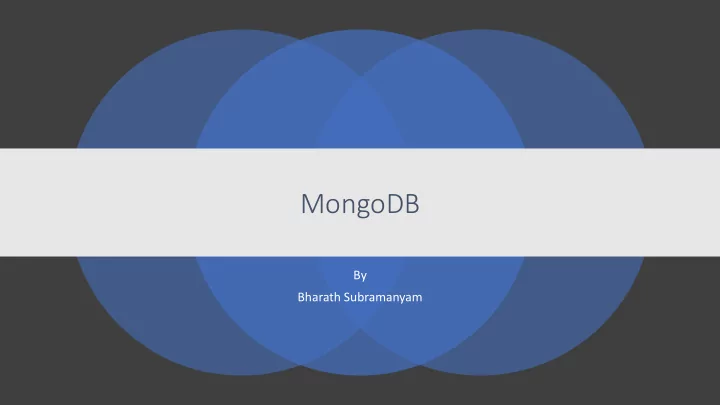

MongoDB By Bharath Subramanyam
• Relational Databases started to become popular in the 80s and have been widely used since then • Properties of Relational Databases- Relational • Fixed Schema Databases • High Level Query Language (SQL) • ACID properties • Primitive Data Partitioning Technology
• Was not designed to run on clusters. Difficult to Problems with scale horizontally Relational Databases • Impedance mismatch problem with Relational Databases
Impedance Mismatch
• Johan Oskarsson – twitter #nosql • Characteristics • Non-relational NoSQL • Cluster Friendly • Schema Less • Mostly Opensource • Simple APIs and no joins
• Key Value Store (like a hashmap which is persistent) • Document Models (MongoDB) (Can group things into natural aggregates) Data Model • Column Family (Get the data with the row key and column family name) • Graph Models
• Database • Collections(Tables) • Document (Row) Document • Fields (Columns) Data model • _id field (Primary Key) • JSON or XML • MongoDB uses JSON format
JSON Format Basic Constructs { “id”: 1200, Base Value = Boolean, int, String.. Object = {} “ customerName ” : “Brad”, Array = [] “ lineItems ” : [ {“ productId ” : 501, “qty” : 5}, {“ productId ” : 553, “qty” : 2} ] }
• JSON object: set of unordered elements • elements: key/value pairs JSON • keys must be unique within an object • values can contain objects • empty value: null, [] (or simply omit element)
• MongoDB documents in a collection must have unique identifier JSON • Documents can be referenced using unique identifier
Mapping Relational Data to JSON
Mapping JSON to Relational DB
Mapping JSON to Relational DB
Aggregates • In OOP Orders and Line Items are created as different Classes • However, Orders and Line Items can be considered as one unit • In Relational Databases, the values are splattered across different tables • However, Document databases save this data in terms of a single unit Orders • It is easier to move back and forth this single unit (You get to store your aggregate at a single Line Item instead of it being spread across clusters)
A Problem with the Document Database • You want to query based on product as the aggregate • Would have to run a Map Reduce job • Problematic when you have to slice and dice your data Orders Line Item Product
Replicas • Why Replication? • High Availability of Data and no Downtime • Disaster Recovery • Replica set is a group of two or more nodes • In a replica set, one node is primary node and remaining nodes are secondary. • All data replicates from primary to secondary node. • At the time of automatic failover or maintenance, election establishes for primary and a new primary node is elected. • After the recovery of failed node, it again join the replica set and works as a secondary node.
Replicas
Sharding • Sharding is the process of breaking the data into pieces and storing them across multiple machines.
Sharding • Shard: This is where the collection data is actually stored. A shard is a replica set. • Config-Server- Config-servers track state about which servers contain what parts of a sharded collection. Sharded clusters have exactly 3 config servers. • Query Routers-The query router processes and targets the operations to shards and then returns results to the clients.
Consistency • Relational Databases – ACID (Atomic, Consistent, Isolation, Durable) • Aggregate Databases- Transaction within an aggregate is ACID. • Two types of Consistency issues- • Logical Consistency • Replication Consistency
Logical Consistency • User Server DB Server User get---> ----> <---- <----get v101 v101 Post v102 Post v102
Replication Consistency • 2 people booking a hotel room example.
CAP Theorem • Choose only 2 • Consistency • Availability • Partition Tolerance • There are levels of Availability and Consistency. A P MongoDB C
Generic MongoDB query • db.collection.find({query}, {projection}) • Eg. db.posts.find({"author" : "Dan Sullivan"}, {"title" : 1})
Thank You!
Recommend
More recommend